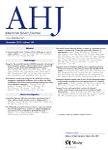版权所有:内蒙古大学图书馆 技术提供:维普资讯• 智图
内蒙古自治区呼和浩特市赛罕区大学西街235号 邮编: 010021

作者机构:Brigham & Womens Hosp Boston MA 02115 USA Hennepin Cty Med Ctr Minneapolis MN 55415 USA Univ Minnesota Minneapolis MN USA
出 版 物:《AMERICAN HEART JOURNAL》 (美国心脏杂志)
年 卷 期:2001年第142卷第4期
页 面:590-593页
核心收录:
学科分类:1002[医学-临床医学] 100201[医学-内科学(含:心血管病、血液病、呼吸系病、消化系病、内分泌与代谢病、肾病、风湿病、传染病)] 10[医学]
主 题:心绞痛/血液 心绞痛/药物疗法 抗凝药/药理学 抗凝药/治疗应用 血液凝固/药物作用 剂量效应关系 药物 用药计划表 依诺肝素/投药和剂量 依诺肝素/药理学 依诺肝素/治疗应用 心脏导管插入术 注射 皮下 昆虫蛋白质类 心肌梗死/血液 心肌梗死/药物疗法 唾液蛋白质类/血液 全血凝固时间 人类
摘 要:Background Enoxaparin has recently been shown to be superior to unfractionated heparin in patients with unstable angina/non-ST-elevation myocardial infarction. Theoretical advantages of low-molecular-weight heparin versus unfractionated heparin include a higher ratio of anti-Xa to anti-IIa activity (3:1 for enoxaparin), a more predictable dose response that precludes the need for frequent monitoring, and the convenience of subcutaneous administration. Both activated partial thromboplastin time and activated clotting time (ACT) are used to monitor anticoagulation with heparin, and ACTs are now standard during percutaneous coronary intervention (PCI) with heparin. At doses of up to 90 mg, subcutaneous enoxaparin leads to a modest dose-related increase in activated partial thromboplastin time, but the effect on ACT is unknown. Methods Thrombolysis In Myocardial Infarction (TIMI) 11A was a multicenter, dose-ranging trial to evaluate the safety and tolerability of subcutaneous enoxaparin in patients with unstable angina/non-ST-elevation myocardial infarction. We obtained peak (mean 4.3 hours after enoxaparin) and trough (mean 11.5 hours after enoxaparin) anti-Xa levels and ACTs for 26 patients in the TIMI 11A trial. Results Despite doses of enoxaparin in the range of 89 +/- 19 mg every 12 hours and significant increases in anti-Xa levels even at trough, there was no change in the ACT measured by HemoTec and only a small increase with Hemachron. The correlation of peak Hemachron ACT with peak anti-Xa levels was poor (R = 0.5, P = .08). Conclusions In contrast to heparin, ACTs are not useful for assessment of anticoagulation with subcutaneous enoxaparin and should not be relied on in patients receiving enoxaparin who require acute PCI. Studies to determine the optimal dose, safety, and efficacy of enoxaparin in patients undergoing PCI are underway.